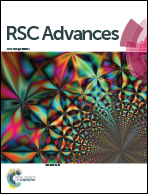Two-step spray-drying synthesis of dense and highly luminescent YAG:Ce3+ phosphor powders with spherical shape†
Abstract
Two-step spray drying using a commercially available spray dryer was carried out to prepare dense and spherical Y3Al5O12:Ce3+ (YAG:Ce3+) particles with good luminescence characteristics. Hollow YAG:Ce3+ powder particles with a thin shell were first obtained by the spray drying of an aqueous precursor solution containing citric acid as an organic additive. The powder was then pulverized into nanoparticles measuring tens of nanometers in size by ball milling. The second spray drying using a colloidal solution of the nanometer-sized precursor powder made it possible to successfully produce spherical YAG:Ce3+ particles with an average size of 2–3 μm. After thermal treatment at a high temperature between 1200 and 1400 °C, spherical YAG:Ce3+ particles with a pure phase and dense structure were obtained. These particles were shown to have good luminescence characteristics suitable for the fabrication of white light-emitting diodes.


 Please wait while we load your content...
Please wait while we load your content...